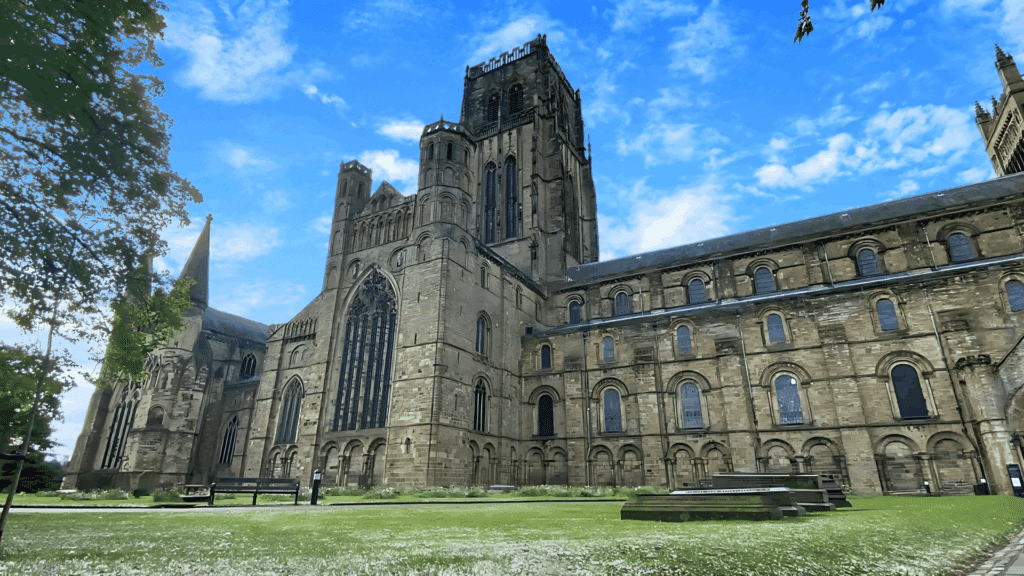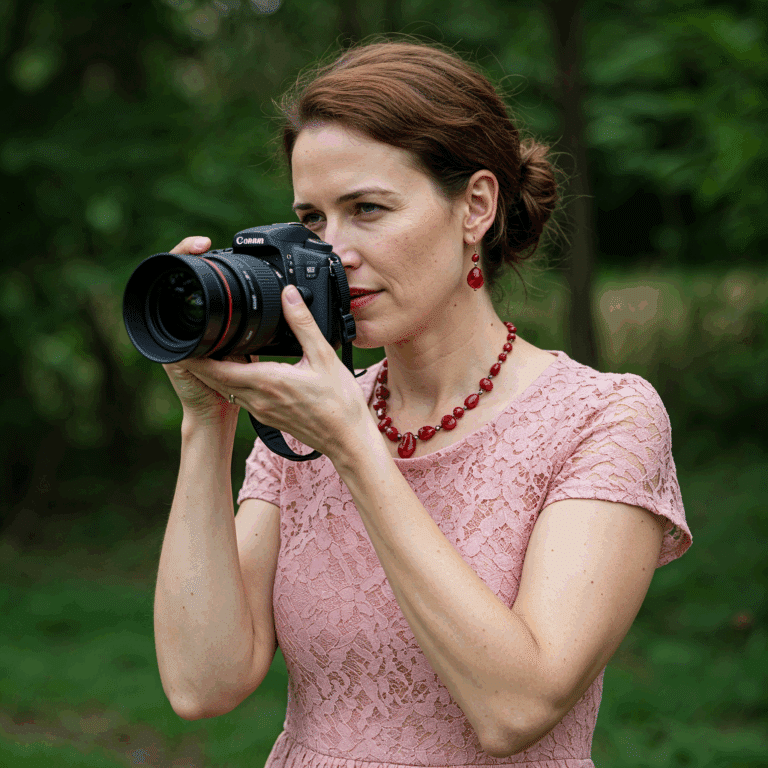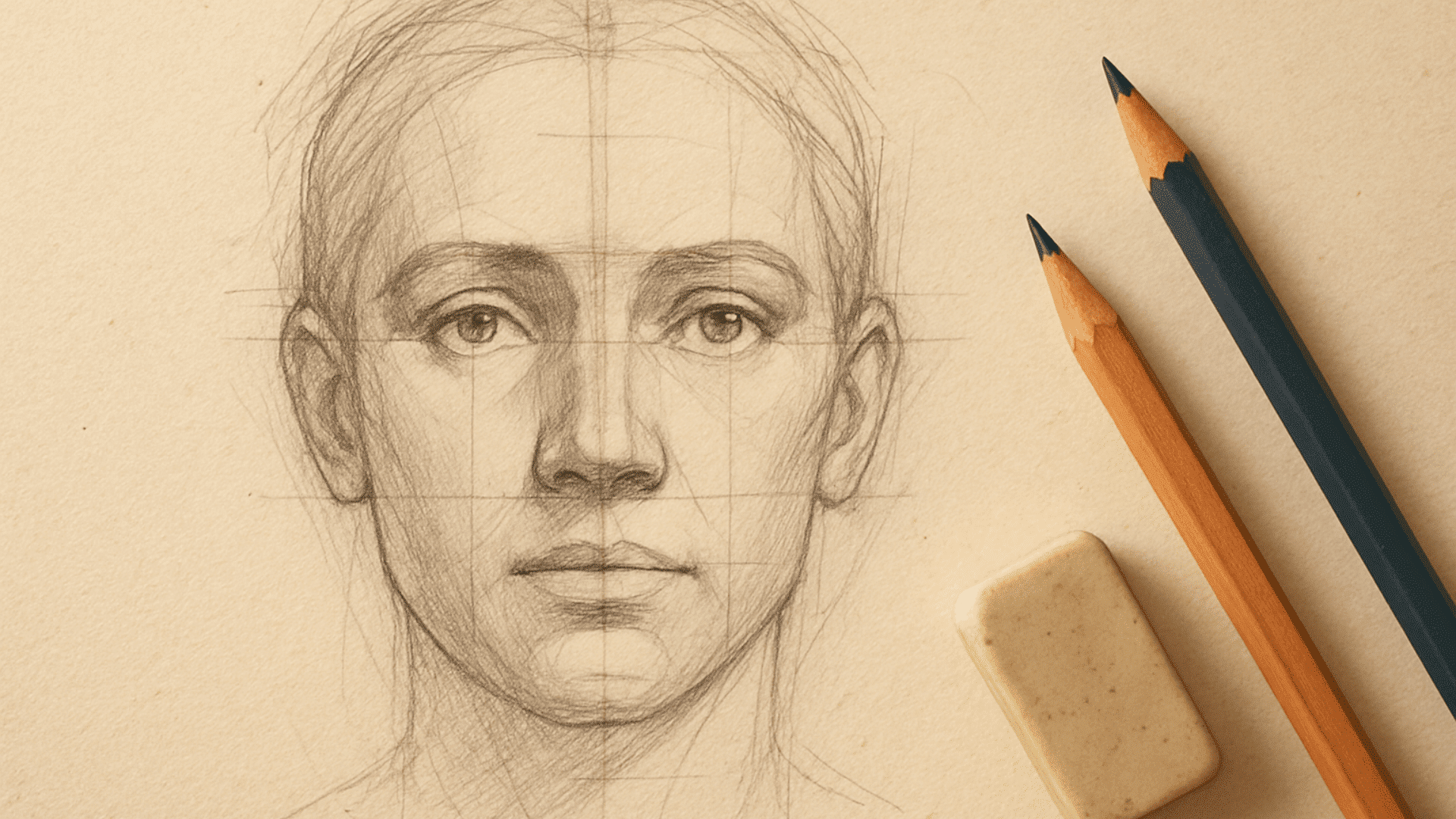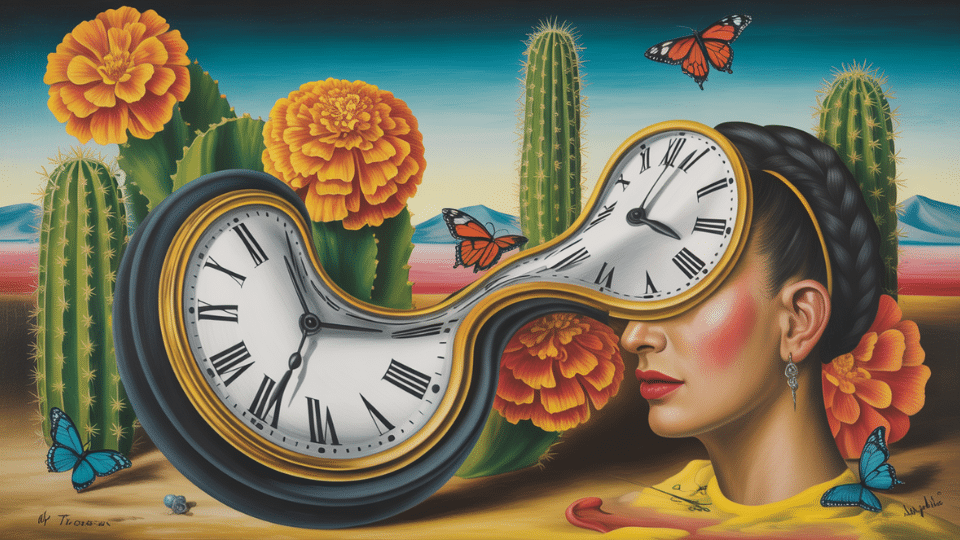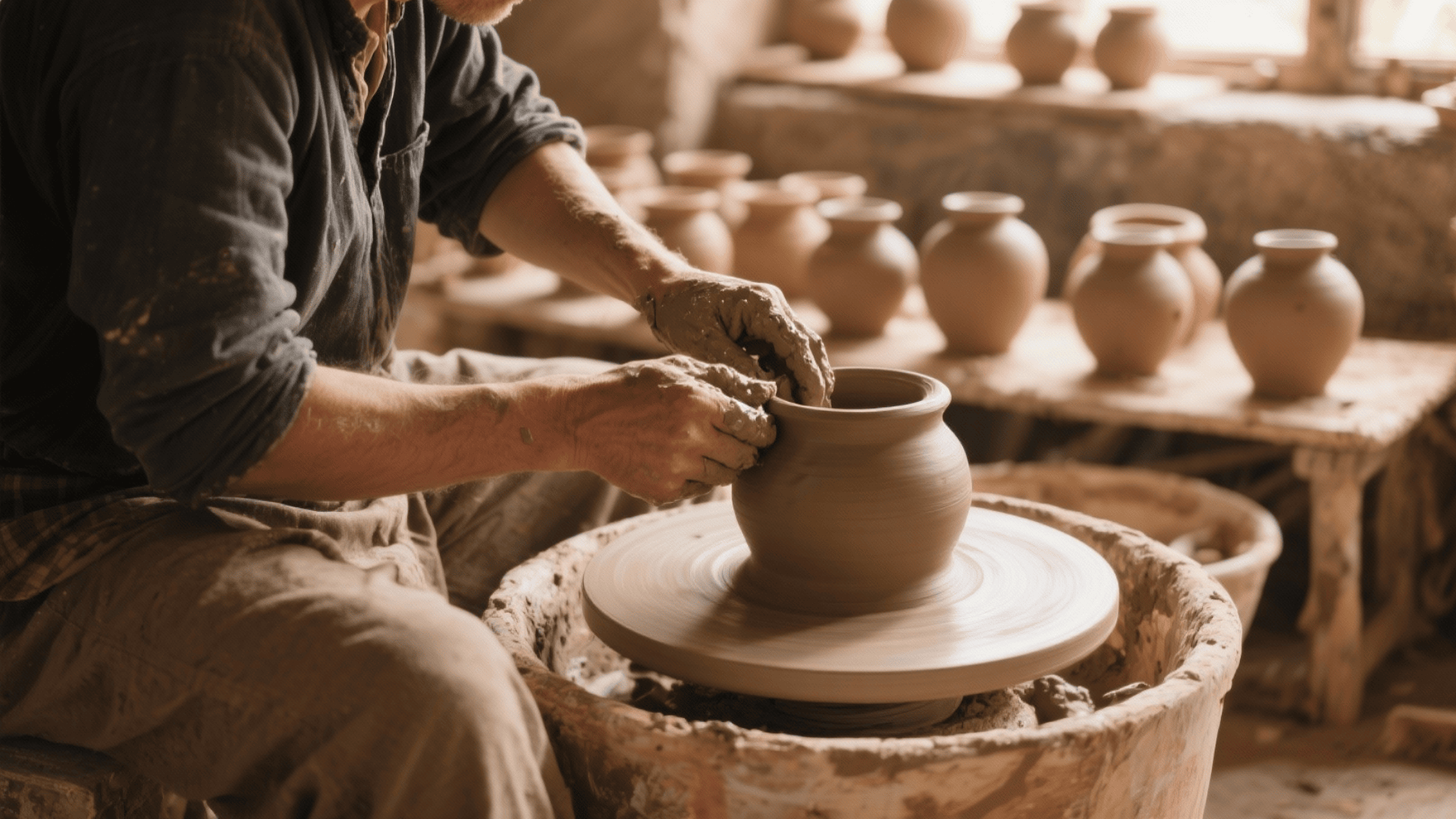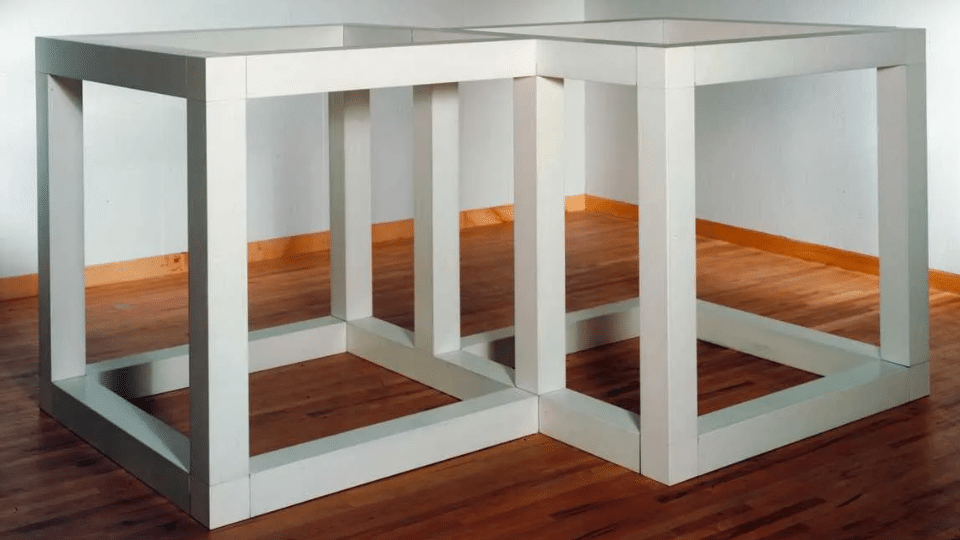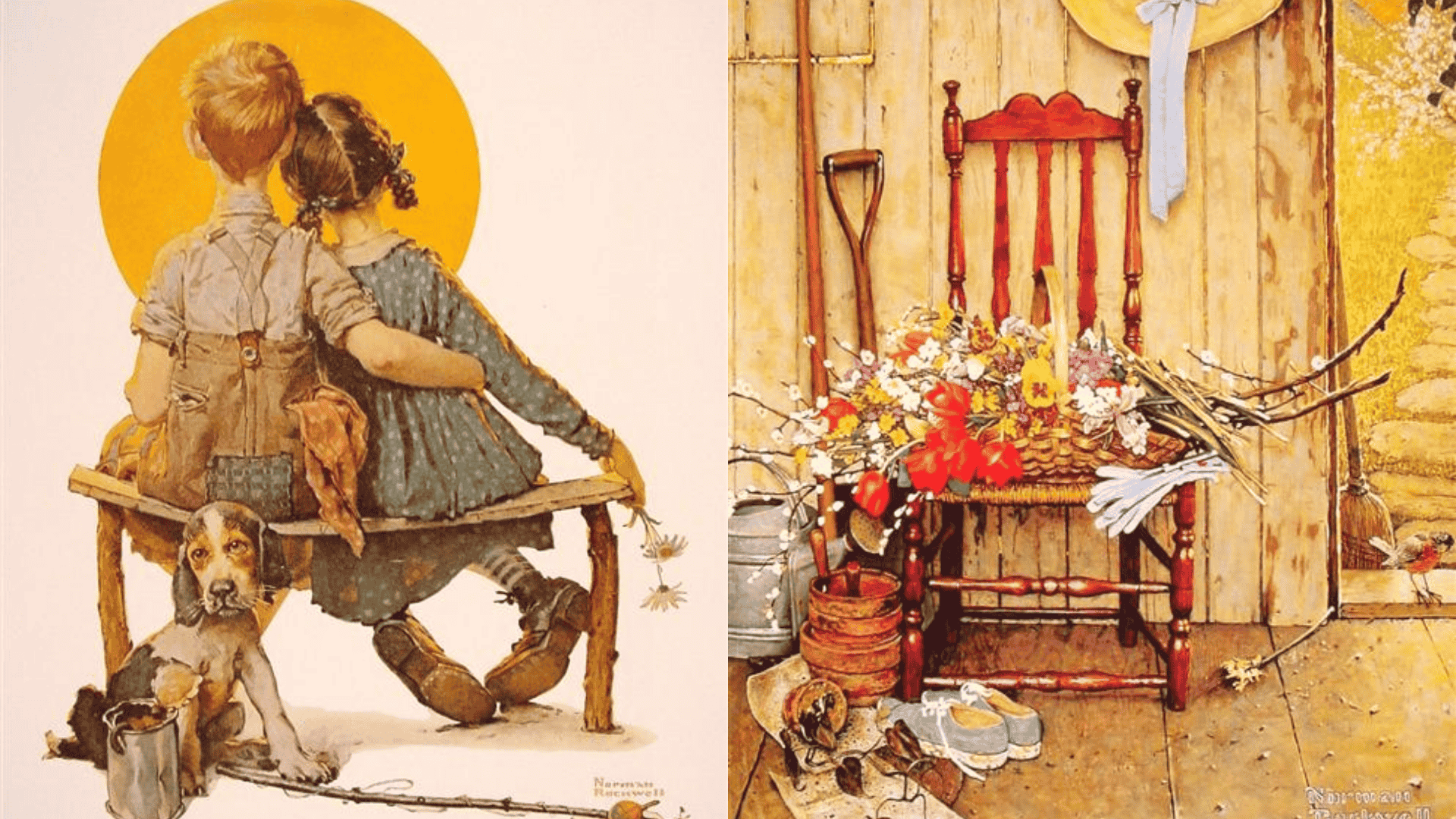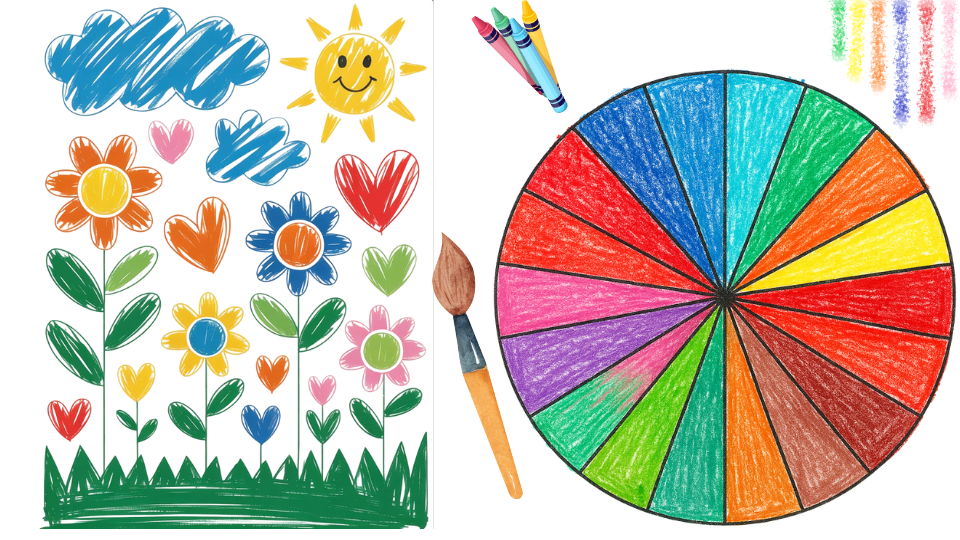Medieval art often seems mysterious and distant to modern viewers. Many people find themselves puzzled by the flat figures, gold backgrounds, and religious symbolism that dominated artistic expression from roughly 500 to 1500 CE.
Yet understanding this art form opens up a window into one of history’s most molded periods.
This blog will guide you through the interesting world of medieval art, explaining its unique characteristics and the historical forces that shaped artistic creation during these centuries.
You’ll learn about the major art forms, key stylistic elements, and the cultural context that made medieval art so distinctive.
By the end, you’ll have a clear understanding of what makes medieval art special and why it remains influential today.
The Essence of Middle Ages Art
Middle Ages art was fundamentally different from what came before or after. Artists during this period, roughly spanning from 500 to 1500 CE, created works primarily to serve God and educate the masses.
Unlike classical Greek and Roman art that celebrated human beauty and realism, medieval artists focused on spiritual messages rather than physical accuracy.
Most medieval art appeared in churches, monasteries, and religious manuscripts. Artists used symbolic colors and gestures to convey their intended meanings.
Gold backgrounds represented the divine realm, while blue symbolized heaven and purity. Figures often appeared flat and stylized because artists prioritized the soul over the physical form.
The Church was the main patron of art during this time. This meant that religious themes dominated everything, from the tiny illuminated letters in books to the massive sculptures in cathedrals.
Art wasn’t just decoration; it was a powerful tool for teaching Christian stories to people who couldn’t read.
Key Medieval Art Characteristics
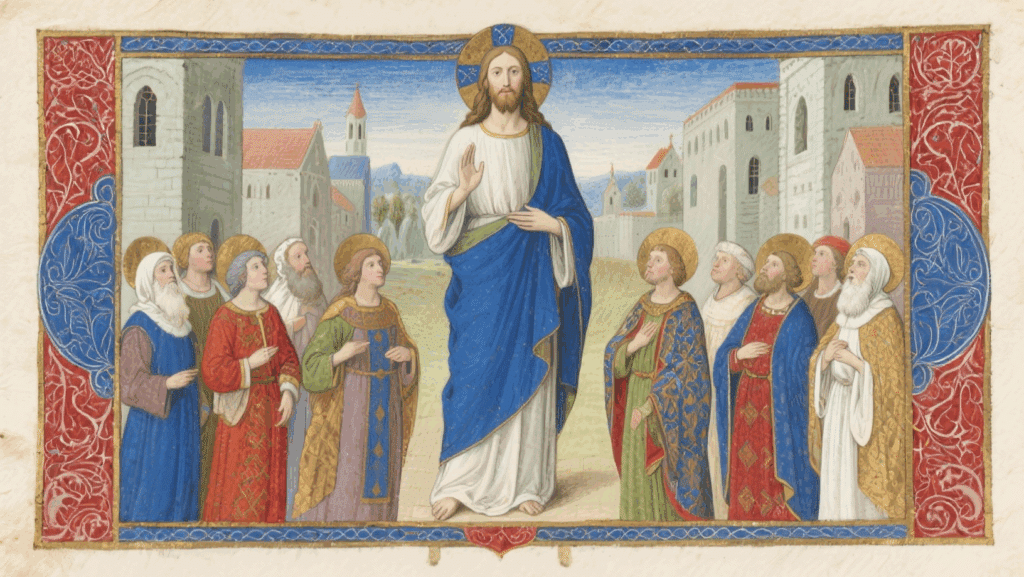
Hierarchical Scale
Size indicated importance in medieval art, not realistic proportions. Christ appeared largest, followed by saints, then ordinary people. A king might tower over his subjects even when standing beside them.
This visual ranking system helped illiterate viewers understand power structures and spiritual significance at a glance.
Frontal Poses and Direct Eye Contact
Figures faced forward and looked straight at viewers. This wasn’t poor artistic skill but intentional design.
Direct eye contact created a spiritual connection between the sacred figure and the worshipper. Side profiles were reserved for less holy characters or narrative scenes.
Lack of Perspective
Medieval artists didn’t use mathematical perspective until the late Gothic period. Buildings looked flat, and distant objects appeared the same size as nearby ones.
Artists focused on showing all important elements clearly rather than creating realistic depth. Multiple viewpoints might appear in a single scene.
Rich Decorative Patterns
Every available surface received ornate decoration. Clothing showed intricate patterns, backgrounds featured geometric designs, and borders overflowed with vines and flowers.
This horror vacui (fear of empty space) reflected medieval belief that God’s creation was abundantly beautiful.
Limited Color Palette
Artists worked with expensive pigments that produced vivid but limited colors. Deep blues from lapis lazuli, bright reds from cinnabar, and pure whites from lead created striking contrasts.
Earth tones were used in less important areas to conserve costly materials.
Workshop Signatures
Regional styles developed as workshops passed techniques through generations. Parisian manuscripts differed from English ones, while Italian frescoes had distinct characteristics compared to German altar panels.
These local traditions created recognizable artistic “fingerprints” across medieval Europe.
Historical Overview: Evolution Through Time
Middle ages art unfolded over a thousand years, evolving through distinct styles that reflected shifting empires, faith, and cultural exchange across Europe.
Early Christian and Byzantine Foundations
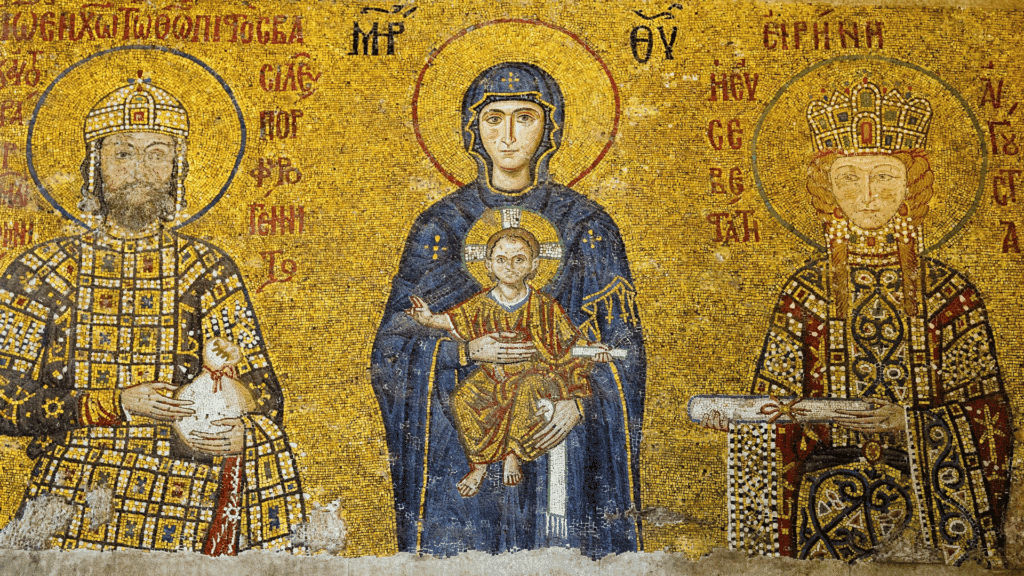
Source: dailysabah.com
Emerging after the fall of Rome, early Christian and Byzantine art focused on spiritual expression. Gold mosaics, icons, and richly decorated churches emphasized divine presence and heavenly authority.
- Timeframe: 5th–7th centuries
- Key Features: Symbolic imagery, mosaics, gold backgrounds, religious focus
- Notable Works/Examples: Hagia Sophia mosaics, Christ Pantocrator icons
Insular Art in the British Isles
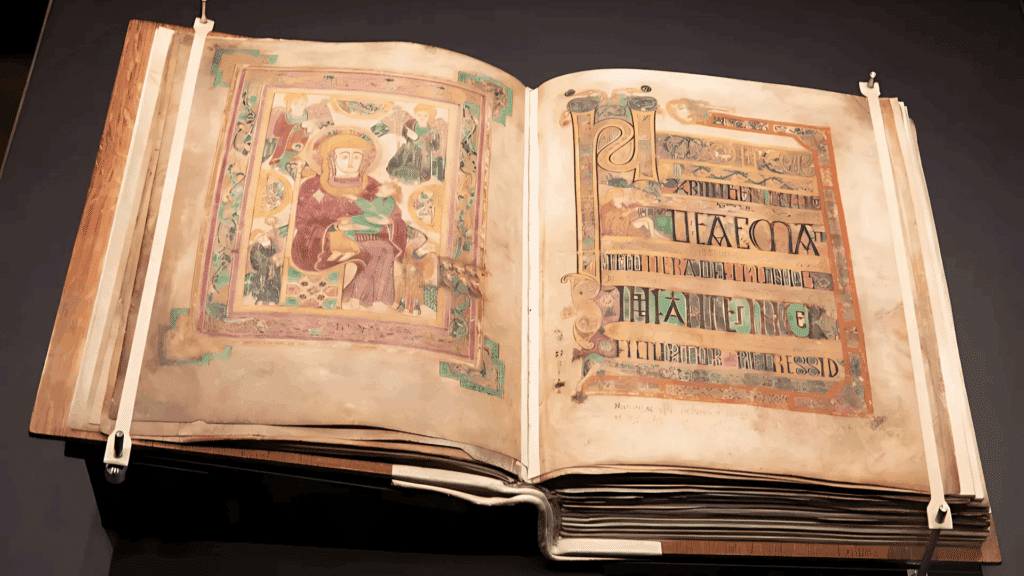
Source: visittrinity.ie
Monks in Ireland and Britain created distinctive art blending Celtic and Christian traditions. Intricate interlace designs, animal motifs, and elaborate manuscripts showcased creativity and devotion.
- Timeframe: 600–900
- Key Features: Interlace patterns, knotwork, manuscript illumination, metalwork
- Notable Works/Examples: Book of Kells, Lindisfarne Gospels
Carolingian Renaissance
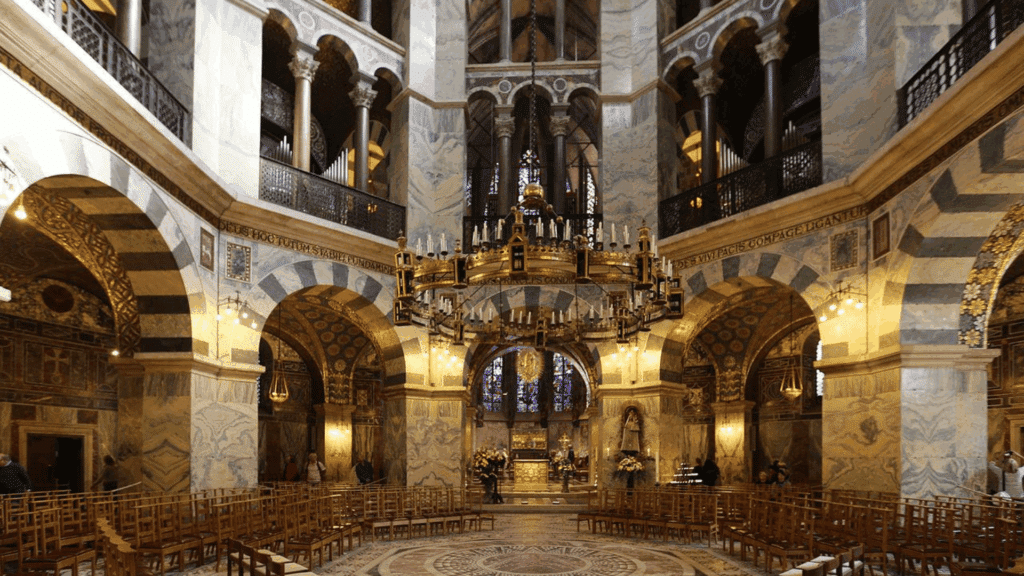
Source: religiana.com
Charlemagne revived classical ideals to unify Christian Europe. Artists emphasized clarity, symmetry, and grandeur in illuminated texts, metalwork, and architecture, signaling a cultural rebirth.
- Timeframe: 8th–9th centuries
- Key Features: Classical influence, imperial grandeur, illuminated manuscripts
- Notable Works/Examples: Coronation Gospels, Palatine Chapel in Aachen
Ottonian Art
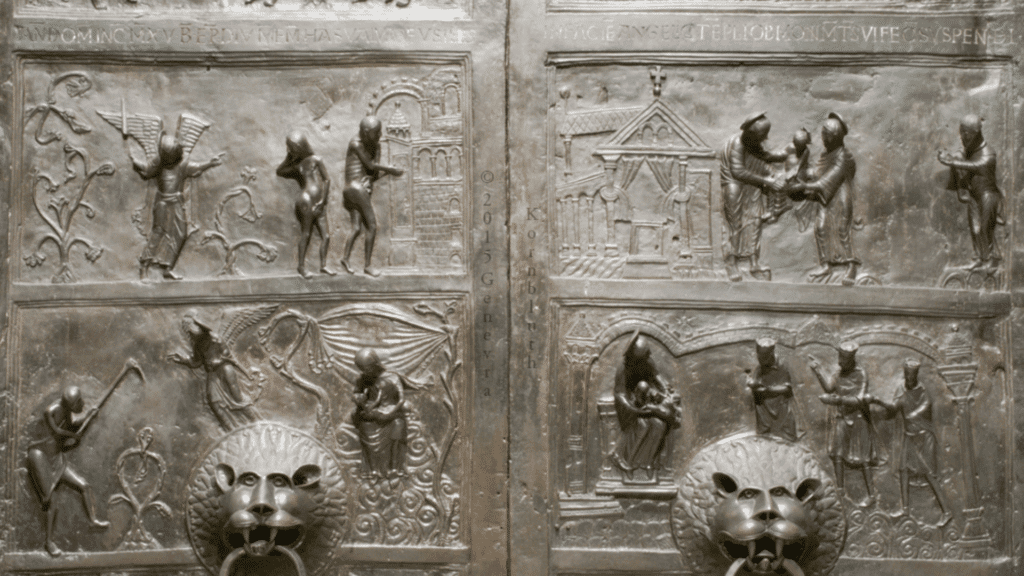
Source: kornbluthphoto.com
Ottonian art built on Carolingian traditions with expressive, monumental works. Richly decorated manuscripts and bold sculptures reflected power, authority, and deep spirituality.
- Timeframe: 10th–11th centuries
- Key Features: Monumental sculptures, expressive figures, lavish manuscripts
- Notable Works/Examples: Gero Cross, Bernward Doors, Codex Aureus of Echternach
Romanesque Period
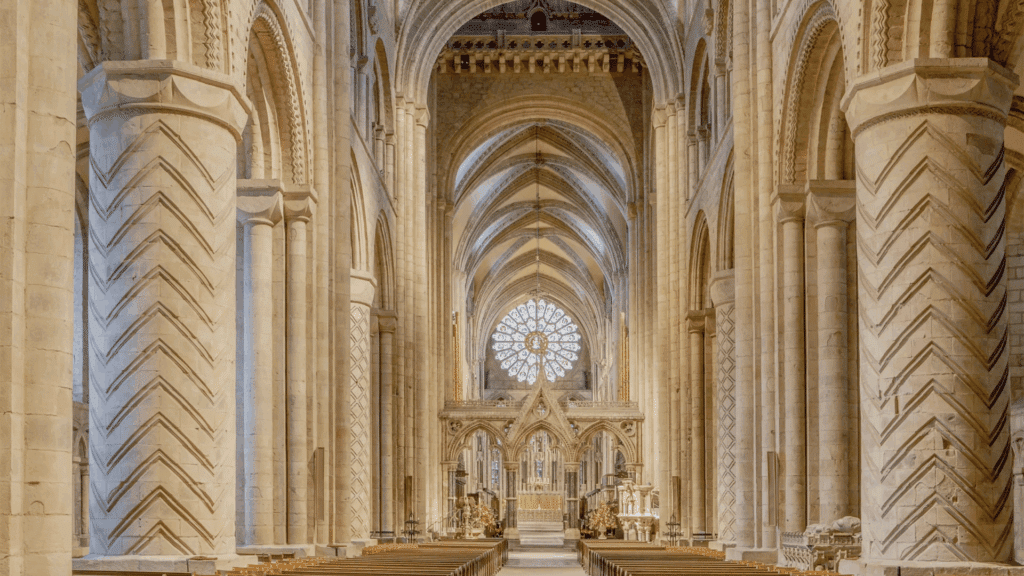
Source: durhamcathedral.co.uk
Art during the Romanesque period emphasized strength and teaching through architecture and decoration. Churches resembled fortresses, with frescoes and carvings guiding the faithful through biblical stories.
- Timeframe: 11th–12th centuries
- Key Features: Rounded arches, thick walls, symbolic frescoes, bold sculptures
- Notable Works/Examples: Abbey Church of Sainte-Foy, Durham Cathedral
Gothic Art (12th–15th Centuries)
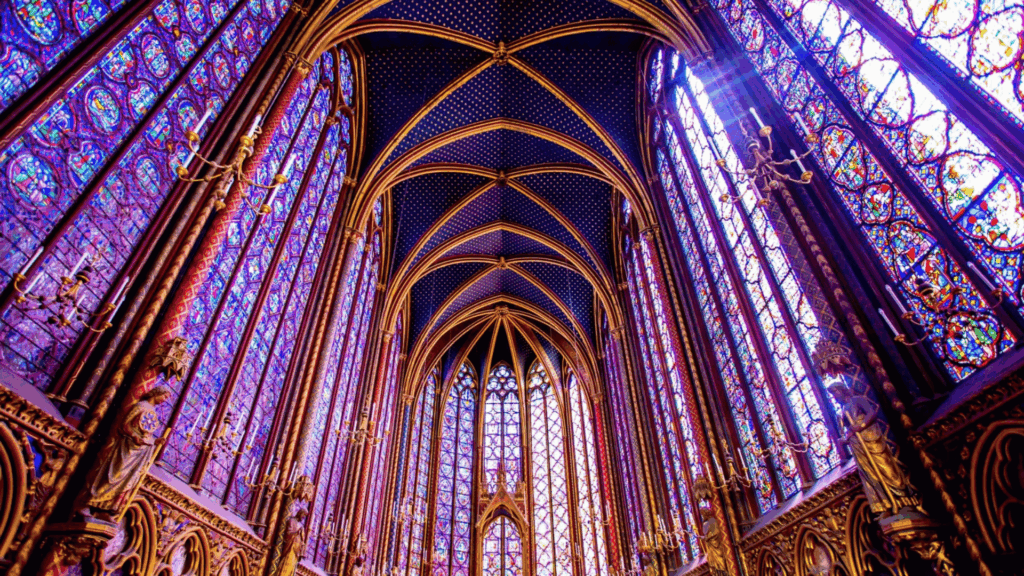
Source: franceguide.info
The Gothic style celebrated light, height, and naturalism. Soaring cathedrals, pointed arches, and radiant stained glass reflected a spiritual connection with heaven and artistic sophistication.
- Timeframe: 12th–15th centuries
- Key Features: Pointed arches, stained glass, naturalistic sculptures, illuminated manuscripts
- Notable Works/Examples: Chartres Cathedral, Sainte-Chapelle, Très Riches Heures du Duc de Berry
Symbolism and Allegory in Medieval Art
| Symbol/Allegory | Meaning | Common Usage in Art |
|---|---|---|
| Lamb | Christ’s sacrifice and purity | Frescoes, manuscript margins, altar pieces |
| Lion | Strength, resurrection, Christ as King | Cathedral sculptures, coats of arms, illuminated texts |
| Peacock | Immortality and eternal life | Mosaics, church decoration, manuscript borders |
| Dove | Holy Spirit and peace | Stained glass windows, baptism scenes, icons |
| Blue | Heaven, divine wisdom, Virgin Mary | Backgrounds in frescoes, Marian iconography |
| Gold | Divine light and eternity | Manuscripts with gold leaf, mosaics, and reliquaries |
| Dragon | Evil, sin, or the devil | Depictions of St. George, cathedral carvings |
| Tree of Life | Eternal salvation and paradise | Cathedral sculpture programs, stained glass |
| Unicorn | Purity, Christ, and virginity | Tapestries, manuscripts, courtly art |
| Skull | Mortality and memento mori | Tomb sculpture, devotional manuscripts |
Techniques and Materials Used by Medieval Artists
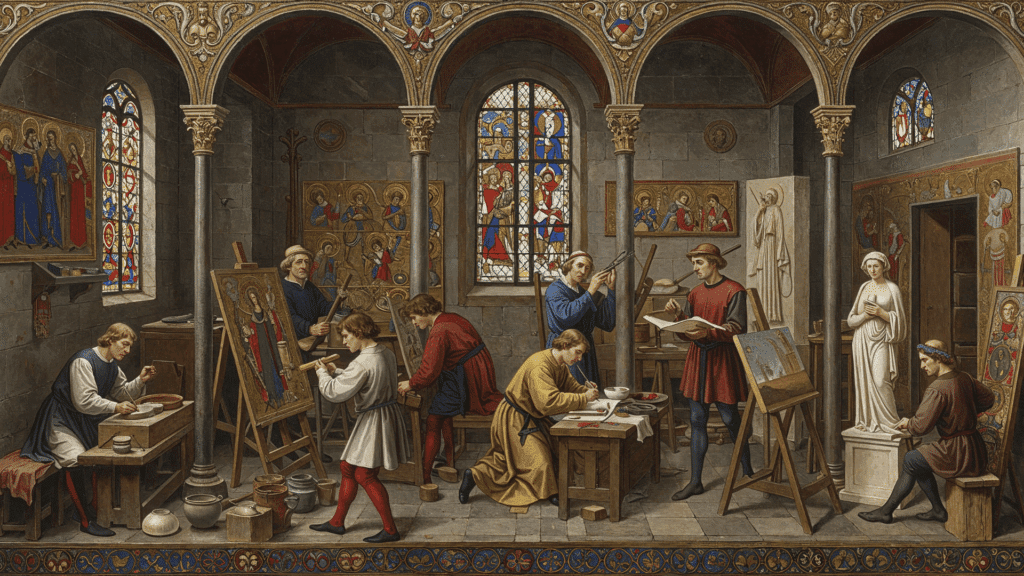
Tempera Painting on Wood Panels
Medieval artists mixed powdered pigments with egg yolk to create tempera paint. This technique produced bright, long-lasting colors that dried quickly.
Artists painted on wooden panels prepared with gesso, a chalk and glue mixture that created a smooth white surface. Multiple thin layers built up rich color depth.
Fresco Painting on Wet Plaster
Church walls received fresco decoration using pigments mixed with lime water. Artists had to work quickly while the plaster remained wet, as the paint bonded chemically with the surface as it dried.
This created permanent murals that lasted centuries when properly executed.
Vellum and Parchment for Manuscripts
Scribes and illuminators worked on animal skin rather than paper. Calfskin vellum provided the finest surface for detailed miniatures, while sheepskin parchment served for everyday manuscripts.
These materials required extensive preparation, including soaking, stretching, and scraping, to achieve the right texture.
Stone Carving Tools and Methods
Sculptors used iron chisels, wooden mallets, and pointed tools to carve limestone and sandstone.
They worked from detailed drawings called cartoons, transferring designs to stone using pounce wheels that perforated the paper. Master carvers handled faces and hands while apprentices roughed out basic forms.
Stained Glass Assembly
Glass makers heated sand, ash, and metallic oxides in furnaces to create colored glass sheets. Artists cut pieces using hot irons, then painted details with vitreous paint that fused to the glass when fired.
Lead strips called cames held the pieces together, with iron armatures supporting large windows.
Precious Metal Leaf Application
Artists applied thin sheets of gold and silver leaf over specially prepared surfaces. They used rabbit skin glue and red clay bole as adhesive bases.
Burnishing with agate tools created the mirror-like finish seen in manuscript borders and panel painting backgrounds.
Natural Pigment Preparation
Colors came from minerals, plants, and insects ground into fine powders. Vermillion red, derived from mercury and sulfur, while ultramarine blue required importing lapis lazuli from Afghanistan.
Artists or their apprentices spent hours grinding these materials on stone slabs with bronze pestles.
Legacy & Influence of Middle Ages Art
Middle ages art impact extends far beyond museum walls into modern creative expression. Gothic Revival architecture emerged in the 18th and 19th centuries, inspiring countless churches, universities, and government buildings worldwide.
The ornate decorative patterns and illuminated manuscript techniques influenced Art Nouveau designers and contemporary graphic artists who still draw inspiration from medieval borders and lettering styles.
Modern fantasy literature and films heavily borrow medieval artistic imagery. Video games, book covers, and movie sets recreate the visual language of knights, castles, and mystical creatures first popularized in medieval manuscripts.
Stained glass techniques continue in architectural projects, while contemporary artists experiment with gold leaf and tempera methods pioneered by medieval masters.
The integration of art and architecture seen in Gothic cathedrals influenced modern public art installations.
Today’s collaborative workshop approaches also echo medieval guild systems, where master artists guide apprentices through traditional techniques passed down through generations.
The Bottom Line
Medieval art remains one of history’s most spiritually powerful and technically innovative artistic movements.
From the glowing mosaics of Byzantine churches to the soaring spires of Gothic cathedrals, these works continue to inspire awe centuries after their creation.
The artists who carved stone angels, painted golden manuscripts, and assembled radiant stained glass windows left behind more than beautiful objects; they created a visual language that still speaks to us today.
Ready to experience middle ages art firsthand? Visit your local museum’s medieval collection or explore a Gothic cathedral near you.

